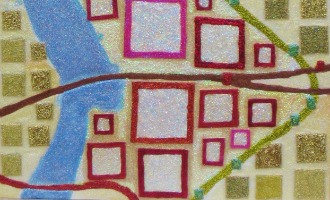
For your summer reading pleasure, BURNAWAY brings you Just Like Suicide, a novel by artist Mery Lynn McCorkle, set in the Los Angeles art world. She writes from experience, having lived for years in Williamsburg, Brooklyn, when it still was the art frontier, and then LA; she now resides in Rome, Georgia. She describes the book as “a compendium of interlocking tales cataloguing self demolition and success in the Los Angeles art scene, from the point of view of artists, dealers and family members.”
We’ll post sequential chapters from McCorkle’s book every Wednesday and Friday over the summer. Or click here to buy the book now.
Nine
Hondo Hines did not graduate from college or attend an art school. He took a grand total of four art classes before submerging himself in the subculture of drugs and clubs. His disjointed, oddly lit, gigantic color photographs fused the sophistication of someone raised in art museums and corporate boardrooms with the guilelessness of an outsider artist. In and out of rehab since he was a teenager, Hines nonetheless produced a prodigious number of works, predominantly of himself and his friends having sex or doing drugs in trendy clubs, and exhibited them internationally. With his long hair and notoriously loose jeans, he attended local openings religiously, often supplying the beer and bong, and threw fundraisers for fellow artists in need. Everywhere he went became a party. A close friend and collaborator on the Guinea Pig Project displayed at the Santa Monica Museum three years ago, Alex Garcia described him as “the sweetest man I’ve ever known. He was gentle and funny and meek and the best friend anyone could ask for.” Hines died last week of a heroin overdose at the age of 27. His photographs are included in the collections of major museums, including the Getty, Museum of Modern Art in New York and the Tate Modern.
Ten
Standing by the brushed aluminum desk, Odessa watched all the folks file into the gallery. She smiled and shared pleasantries with an unctuous line of artists who came over to greet her. Mostly she half sat on the desk. Three hours is an inch short of eternity if you’re standing on cement in high heels. Forty minutes into this event, Alex and Tommy came in with a frowning Lori whose newest paintings were in the large side room. She seemed slightly drunk or pissed off or maybe it was the combination of an uneven floor and the sleek pink stilettos she was wearing. Odessa had never seen her in anything other than sandals before. It takes some practice to walk gracefully in four inch heels.
She could hear Teresa greeting friends who were admiring her paintings in the back room, everything tinted red from the sunset glowing in through the sky lights. This was her second solo show with the gallery and she arrived even more nervous than she had for the first opening. Her first show had sold fairly well so she probably was worried about the reception for the big shift in her work. Telling an artist everything is fine, though, generally just makes them more nervous.
According to the statement on her website, Odessa became a gallery owner because of a fascination with the creative process. She thought it sounded kind of pompous but the truth sometimes does. She really was fascinated with how artists converted the detritus of their lives into something greater than themselves, personal yet universal. How such timidity at an opening could create such powerfully evocative work. How one subject matter, like sex, could have so many interpretations. Both Lori and Teresa dealt with sexual content, both were explicit in doing so, yet their work, while often described with the same adjectives, was so very different from each other. Nine months ago, Lori was painting drippy figurative paintings. They carried a sense of abandonment within them, a wildness, almost recklessness. One critic said they looked as if the artist had licked them into being. Teresa, who was older and from the Bay Area, painted with more deliberation, more agony, building a tight under-painting, a palimpsest of struggle to find the right curve, the right color, each layer leaving behind the tell tale texture of trial and error like scars and warts, and at the end she hurled veils of translucent washes to drip down. They were about as erotic as art could ever hope to be. Both of these artists had also abruptly shifted from their signature content in the past year.
Putting them in such close proximity, Odessa figured, should generate a conversation, both in terms of technique and the fact that two strangers in the same time frame went from painting lusty figures to rendering empty rooms. Was it something in the Zeitgeist which shifted from hedonism to a protective solitude, from vibrant color to severely restricted palettes? She knew that Lori had deaths in the past eight months to deal with but Teresa hadn’t mentioned any reason for the change and it was bad manners to straight out ask about something so personal. Odessa expected a critic to note this shift and write about how it reflected the direness of the times. She, however, had learned to keep any expectations in LA at bay. Expectations brought frustration. Admittedly, frustration was inherent in this business everywhere. In LA, though, frustration was considered a scary negative energy to be avoided. Even being snippy about LA was a negative energy. As her future daughter-in-law chided her at every opportunity, “negative energy is contagious.” The young woman personified every cliché of a southern Californian. And what was her other exhortation? “Breathe in the now.” Oh, leaping lords. Weren’t the holidays going to be a passel of fun.





